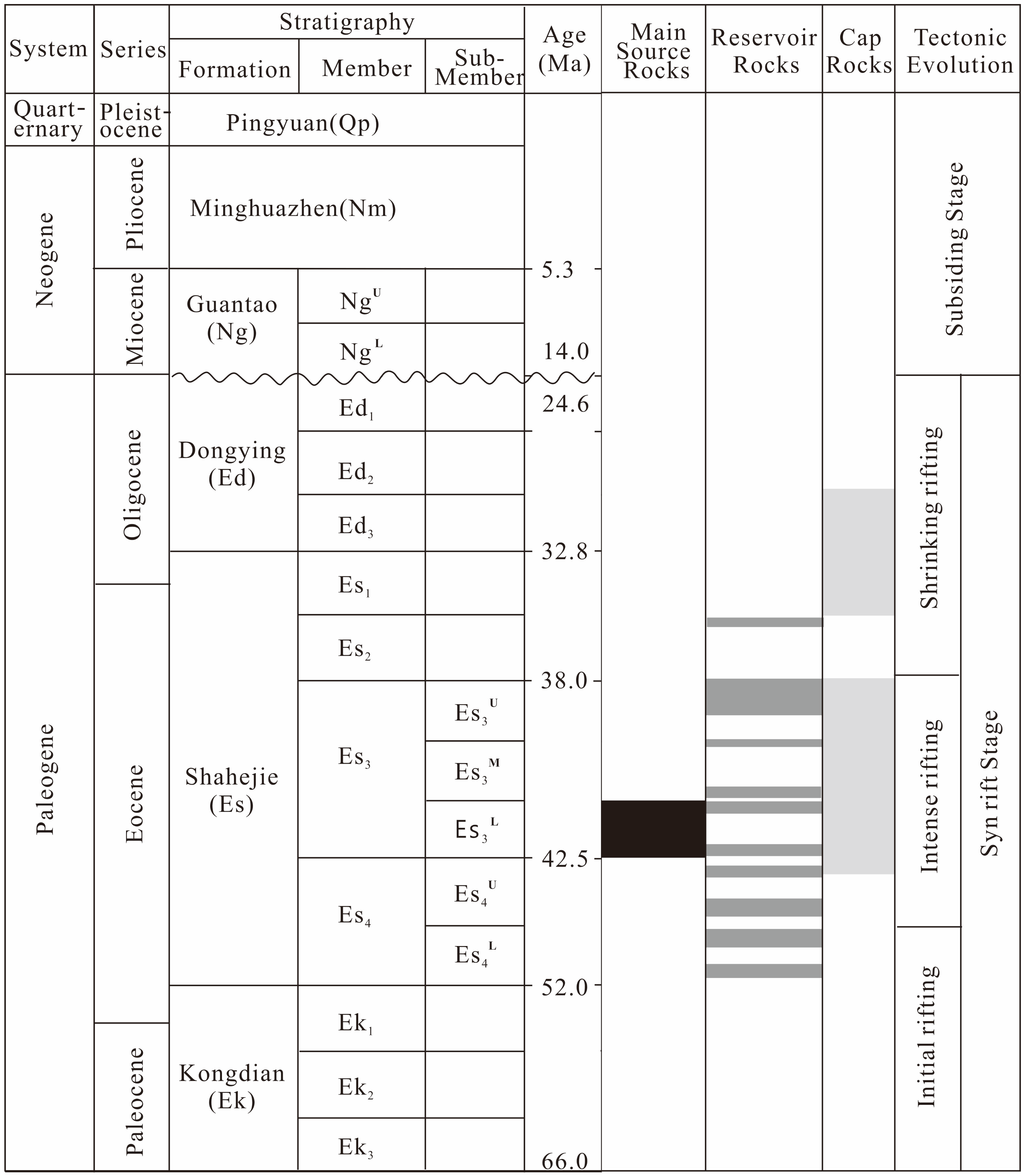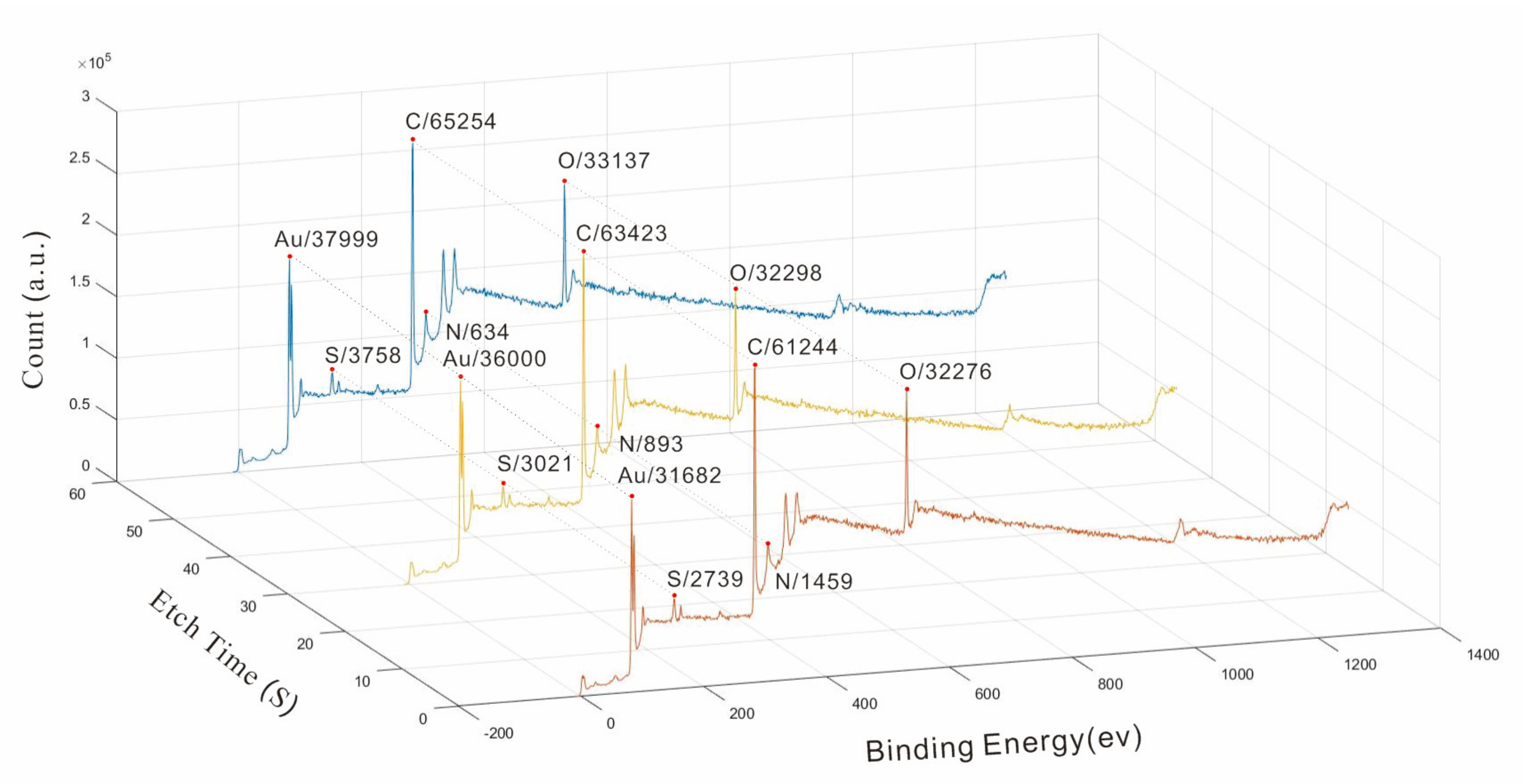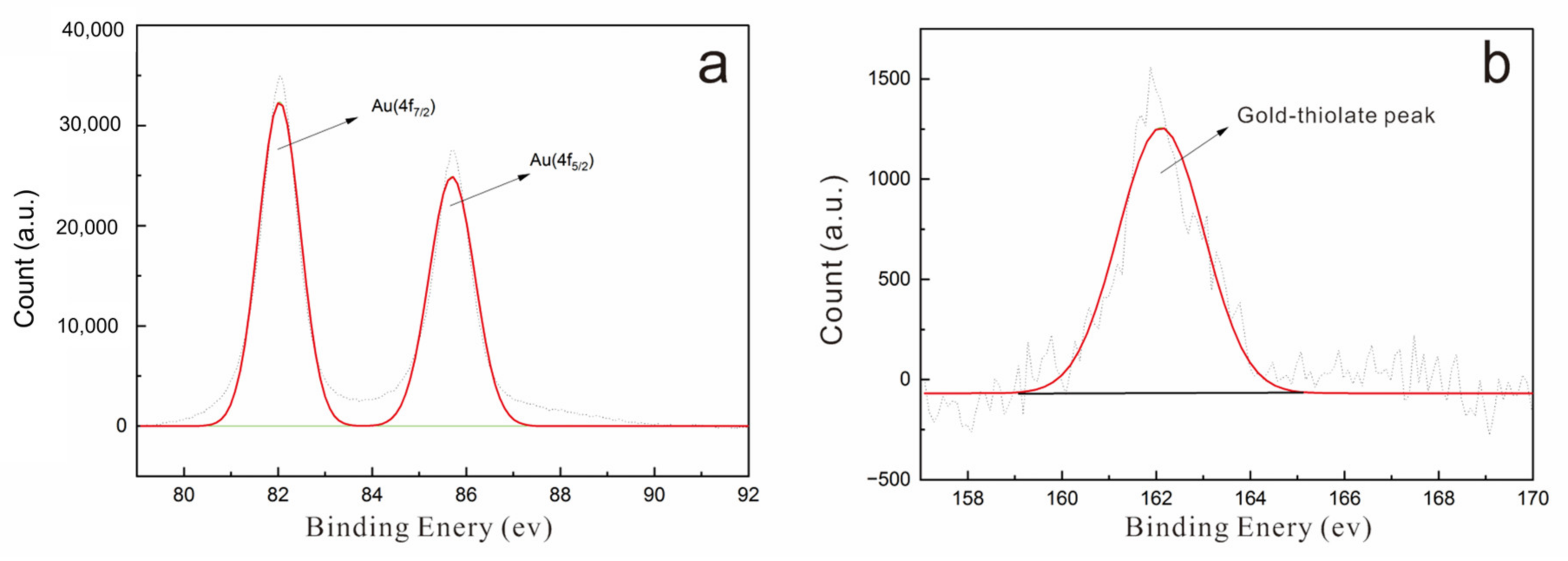Occurrence of State of Gold in Crude Oil and Its Economic Significance
Abstract
:1. Introduction
2. Geological Setting
3. Materials and Methods
3.1. Determination of Au Contents
3.2. Au-Tube Thermal Simulation
3.3. XPS Analysis
3.4. Determination of Total Acid Values of Crude Oil
3.5. The Gas Chromatography–Mass Spectrometry (GC-MS) Analysis
4. Results
4.1. Crude Oil Au, S, and Total Acid Contents
4.2. XPS Analyses
5. Discussion
6. Conclusions
Author Contributions
Funding
Data Availability Statement
Acknowledgments
Conflicts of Interest
References
- Gu, X.X.; Zhang, Y.M.; Li, B.H.; Xue, C.J.; Dong, S.Y.; Fu, S.H.; Cheng, W.B.; Liu, L.; Wu, C.Y. The coupling relationship between metallization and hydrocarbon accumulation in sedimentary basins. Earth Sci. Front. 2010, 17, 83–105. [Google Scholar]
- Clark, J.R.; Williams-Jones, A.E. Analogues of epithermal gold–silver deposition in geothermal well scales. Nature 1990, 346, 644–645. [Google Scholar] [CrossRef]
- Williams-Jones, A.E.; Migdisov, A.A. An experimental study of the solubility of gold in crude oil: Implications for ore genesis. Geochim. Cosmochim. Acta 2006, 70, A703. [Google Scholar] [CrossRef]
- Emsbo, P.; Williams-Jones, A.; Koenig, A.E.; Wilson, S.A. Petroleum as an agent of metal transport: Metallogenic and exploration implications. In Proceedings of the Tenth Biennial SGA Meeting, Townsville, Australia, 17–20 August 2009; pp. 99–101. [Google Scholar]
- Hu, S.-Y.; Plet, C. Introduction to a special issue on organic- and microbe-metal interactions in mineral systems. Ore Geol. Rev. 2022, 146, 104938. [Google Scholar] [CrossRef]
- Gu, X.X.; Zhang, Y.M.; Li, B.H.; Dong, S.Y.; Xue, C.J.; Fu, S.H. Hydrocarbon- and ore-bearing basinal fluids: A possible link between gold mineralization and hydrocarbon accumulation in the Youjiang basin, South China. Miner. Depos. 2012, 47, 663–682. [Google Scholar] [CrossRef]
- Large, R.R.; Bull, S.W.; Maslennikov, V.V. A Carbonaceous Sedimentary Source-Rock Model for Carlin-Type and Orogenic Gold Deposits. Econ. Geol. 2011, 106, 331–358. [Google Scholar] [CrossRef]
- Hulen, J.B.; Collister, J.W.; Stout, B.; Curtiss, D.K.; Dahdah, N.F. The exhumed “Carlin-type” fossil oil reservoir at Yankee Basin. JOM 1998, 50, 30–34. [Google Scholar] [CrossRef]
- Collister, J.W.; Hulen, J.B. The oil-bearing, carlin-type gold deposits of Yankee Basin, Alligator Ridge District, Nevada. Econ. Geol. 1999, 94, 1029–1049. [Google Scholar]
- Wang, G.Z.; Hu, R.Z.; Su, W.C.; Zhu, L.M. Fluid and mineralization of Youjiang Basin in the Yunnan-Guizhou-Guangxi area, China. Sci. China (Ser. D Earth Sci.) 2002, 46, 99–109. [Google Scholar]
- Hu, Y.; Liu, W.; Wang, J.; Zhang, G.; Zhou, Z.; Han, R. Basin-scale structure control of Carlin-style gold deposits in central Southwestern Guizhou, China: Insights from seismic reflection profiles and gravity data. Ore Geol. Rev. 2017, 91, 444–462. [Google Scholar] [CrossRef]
- Hu, Y.Z.; Han, R.S.; Mao, X.X. Relationship between metal mineralization and accumulation oil and gas in the eastern Guizhou. Geol. Prospect. 2007, 43, 51–56. [Google Scholar]
- Arehart, G.B. Characteristics and origin of sediment-hosted disseminated gold deposits: A review. Ore Geol. Rev. 1996, 11, 383–403. [Google Scholar] [CrossRef]
- Peters, K.E.; Walters, C.C.; Moldowan, J.M. The Biomarker Guide: Volume 2, Biomarkers and Isotopes in Petroleum Systems and Earth History; Cambridge University Press: Cambridge, UK, 2007. [Google Scholar]
- Su, W.C. Geochemistry of the Ore-Forming Fluids of the Carlin-Type Gold Deposits in the Southwestern Margin of theYangtze Block. Doctoral Dissertation, Institute of Geochemistry. Chinese Academy of Scicnces, Guiyang, China, 2002; pp. 1–120. [Google Scholar]
- Xia, Y.; Chen, Q.N.; Zhou, W.C. The simulating experiments of gold mineralization in low temperature and open system. J. Nanjing Univ. (Nat. Sci.) 1996, 32, 634–639. [Google Scholar]
- Liu, J.Z. Ore characteristics and gold occurrence of the Shuiyindong gold deposit, guizhou. Guizhou Geol. 2003, 20, 30–34. [Google Scholar]
- Liu, J.Z.; Deng, Y.M.; Liu, C.Q.; Zhang, X.C.; Xia, Y. Metallogenic conditions and model of the superlarge Shuiyindong stratabound gold deposit in Zhenfeng County, Guizhou Province. Geol. China 2006, 33, 169–177. [Google Scholar]
- Liu, J.Z.; Xia, Y.; Zhang, X.C.; Deng, Y.M.; Su, W.C.; Tao, Y. Model of strata Karlin-type gold deposit: The Shuiyindong super-scale gold deposit. Gold Sci. Technol. 2008, 16, 1–15. [Google Scholar]
- Tu, G.Z. Gechemisty of Strata-Bound Deposits in China (Volume III); Science Press: Beijing, China, 1988. [Google Scholar]
- Fu, J.M.; Peng, P.A.; Lin, Q.; Liu, D.H.; Jia, R.F.; Shi, J.X.; Lu, J.L. Several problems in the study of organic gechemisty of strata-bound Deposits. Prog. Earth Sci. 1990, 5, 43. [Google Scholar]
- Parnell, J. Metal enrichments in solid bitumens: A review. Miner. Depos. 1988, 23, 191–199. [Google Scholar] [CrossRef]
- Jedwab, J.; Badaut, D.; Beaunier, P. Discovery of a palladium-platinum-gold-mercury bitumen in the Boss Mine, Clark County, Nevada. Econ. Geol. 1999, 94, 1163–1172. [Google Scholar] [CrossRef]
- Baker, W.E. The role of humic acid in the transport of gold. Geochim. Et Cosmochim. Acta 1978, 42, 645–649. [Google Scholar] [CrossRef]
- Liu, J.Z.; Fu, J.M.; Lu, J.L. Experimental study on the role of organic matter in the mineralization of Sedimentary-reformed gold deposits. Sci. China (Ser. B) 1993, 9, 993–1000. [Google Scholar]
- Zhang, J.R.; Lu, J.J.; Yang, F.; Wu, J.W.; Zhu, F.H. An experimental study on gold solubility in amino acid solution and its geological signifcance. Geochimica 1996, 25, 190–195. [Google Scholar]
- Crede, L.-S.; Liu, W.; Evans, K.; Rempel, K.; Testemale, D.; Brugger, J. Crude oils as ore fluids: An experimental in-situ XAS study of gold partitioning between brine and organic fluid from 25 to 250 °C. Geochim. Et Cosmochim. Acta 2019, 244, 352–365. [Google Scholar] [CrossRef]
- Xu, Z.H.; Zhan, Y.L.; Zhu, J.H.; Li, X. The research progress in the utilization of metal resources in crude oils. Multipurp. Util. Miner. Resour. 1998, 3, 22–26. [Google Scholar]
- Taylor, S.R.; Mclennan, S.M. The Continental Crust: Its Composition and Evolution; Blackwell Scientific Publications: Oxford, UK, 1985. [Google Scholar]
- Wang, D.; Wu, Z.P.; Yang, L.L.; Liu, H.; Zhang, Y. Growth and linkage of the Xiakou fault in the Linnan Sag, Jiyang Depression, Eastern China: Formation mechanism and sedimentation response. Mar. Pet. Geol. 2020, 116, 104319. [Google Scholar] [CrossRef]
- Li, C.; Zhang, L.K.; Luo, X.R.; Wang, B.; Lei, Y.H.; Cheng, M.; Luo, H.M.; Wang, C.J.; Yu, L. Modeling of overpressure generation-evolution of the Paleogene source rock and implications for the Linnan Sag, Eastern China. Front. Earth Sci. 2022, 10, 829322. [Google Scholar] [CrossRef]
- Guo, X.L.; Xiong, M.; Zhou, Q.; Tian, H.; Xiao, X.M. Petroleum generation and expulsion kinetics: A sase study of the Shahejie Formation source rocks from Linnan Sag of Huimin Depression. ACTA Sedmentol. SINICA 2009, 27, 723–731. [Google Scholar]
- GB/T 264-1983; Petroleum Products—Determination of Acid Number. National Bureau of Standards: Beijing, China, 1983.
- Sun, Y.Z.; Jiao, W.W.; Zhang, S.C.; Qin, S.J. Gold enrichment mechanism in crude oils and source rocks in jiyang depression. Energy Explor. Exploit. 2009, 27, 133–142. [Google Scholar] [CrossRef]
- Pearson, R.G. Hard and Soft Acids and Bases. J. Am. Chem. Soc. 1963, 85, 3533–3539. [Google Scholar] [CrossRef]
- Seward, T.M. Thio complexes of gold and the transport of gold in hydrothermal ore solutions. Geochim. Cosmochim. Acta 1973, 37, 379–399. [Google Scholar] [CrossRef]
- Giordano, T.H. Evaluation of Organic Ligands and Metal-Organic Complexing in Mississippi Valley-Type Ore Solutions. Econ. Geol. 1985, 80, 96–106. [Google Scholar] [CrossRef]
- Vlassopoulos, D.; Wood, S.A.; Mucci, A. Gold speciation in natural waters: II. The importance of organic complexing- Experiments with some simple model ligands. Geochim. Cosmochim. Acta 1990, 54, 1575–1586. [Google Scholar] [CrossRef]
- Sanz-Robinson, J.; Williams-Jones, A.E. The solubility of Nickel (Ni) in crude oil at 150, 200 and 250°C and its application to ore genesis. Chem. Geol. 2020, 533, 119443. [Google Scholar] [CrossRef]
- Hughey, C.A.; Rodgers, R.P.; Marshall, A.G.; Walters, C.C.; Qian, K.; Mankiewicz, P. Acidic and neutral polar NSO compounds in Smackover oils of different thermal maturity revealed by electrospray high field Fourier transform ion cyclotron resonance mass spectrometry. Org. Geochem. 2004, 35, 863–880. [Google Scholar] [CrossRef]
- Castner, D.G.; Hinds, K.; Grainger, D.W. X-ray Photoelectron Spectroscopy Sulfur 2p Study of Organic Thiol and Disulfide Binding Interactions with Gold Surfaces. Langmuir 1996, 12, 5083–5086. [Google Scholar] [CrossRef]
- Sanz-Robinson, J.; Sugiyama, I.; Williams-Jones, A.E. The solubility of palladium (Pd) in crude oil at 150, 200 and 250 °C and its application to ore genesis. Chem. Geol. 2020, 531, 119320. [Google Scholar] [CrossRef]
- Lewan, M.D. Factors controlling the proportionality of vanadium to nickel in crude oils. Geochim. Cosmochim. Acta 1984, 48, 2231–2238. [Google Scholar] [CrossRef]
- Giordano, T.H. Metal Transport in Ore Fluids by Organic Ligand Complexation. In Organic Acids in Geological Processes; Pittman, E.D., Lewan, M.D., Eds.; Springer: Berlin/Heidelberg, Germany, 1994; pp. 319–354. [Google Scholar]
- Speight, J.G. Handbook of Petroleum Analysis; John Wiley & Sons Inc: Hoboken, NJ, USA, 2001. [Google Scholar]
- Park, L.K.E.; Liu, J.; Yiacoumi, S.; Borole, A.P.; Tsouris, C. Contribution of acidic components to the total acid number (TAN) of bio-oil. Fuel 2017, 200, 171–181. [Google Scholar] [CrossRef]
- Lewan, M.D.; Fisher, J.B. Organic Acids from Petroleum Source Rocks. In Organic Acids in Geological Processes; Pittman, E.D., Lewan, M.D., Eds.; Springer: Berlin/Heidelberg, Germany, 1994. [Google Scholar]
- Barth, T.; Bjørlykke, K. Organic acids from source rock maturation: Generation potentials, transport mechanisms and relevance for mineral diagenesis. Appl. Geochem. 1993, 8, 325–337. [Google Scholar] [CrossRef]
- Kawamurat, K.; Tannenbaum, E.L.I.; Huizinga, B.J.; Kaplan, I.R. Long-chain carboxylic acids in pyrolysates of Green River kerogen. Adv. Org. Geochem. 1986, 10, 1059–1065. [Google Scholar] [CrossRef]
- Shock, E.L. Organic acid metastability in sedimentary basins. Geology 1988, 16, 886–890. [Google Scholar] [CrossRef]
- Head, I.M.; Jones, D.M.; Larter, S.R. Biological activity in the deep subsurface and the origin of heavy oil. Nature 2003, 426, 344–352. [Google Scholar] [CrossRef]
- Wenger, L.M.; Davis, C.L.; Isaksen, G.H. Multiple Controls on Petroleum Biodegradation and Impact on Oil Quality. SPE Reserv. Eval. Eng. 2002, 5, 375–383. [Google Scholar] [CrossRef]






| Oilfield | Well | Fm. | Depth (m) | Density (g/cm3) | Viscosity (mpa.s) | S (%) | TAN (mg/g) | Au (ppb) |
|---|---|---|---|---|---|---|---|---|
| Linpan | L2-x201 | G2 | 1414.4–1423.6 | 0.945 | 377.75 | 0.51 | 1.63 | 13.4 |
| Linpan | L23-11 | G3 | 1642.2–1645.0 | 0.923 | 90.90 | 0.37 | 0.95 | 105.3 |
| Linpan | L55 | S3 | 2626.6–2992.8 | 0.866 | 11.07 | 0.12 | 0.92 | 90.7 |
| Linpan | L7-x28 | S2 | 1799.2–1823.6 | 0.909 | 27.46 | 0.10 | 0.64 | 12.0 |
| Linpan | L75-17 | S3 | 1859.2–1909.0 | 0.918 | 138.00 | 0.35 | 1.11 | 24.4 |
| Linpan | L75-x30 | S4 | 2474.0–2512.6 | 0.895 | 18.00 | 0.35 | 1.09 | 16.0 |
| Linpan | L76-3 | S4 | 2069.0–2094.0 | 0.893 | 41.00 | 0.10 | 0.82 | 32.4 |
| Linpan | P14-6 | S4 | 1588.6–1594.4 | 0.986 | 5951.00 | 0.50 | 1.39 | 36.6 |
| Linpan | P18-x3 | S3 | 1597.1–1630.3 | 0.935 | 119.00 | 0.42 | 1.21 | 38.1 |
| Linpan | P20-6 | S1 | 1556.0–1599.4 | 0.936 | 352.30 | 0.25 | 1.36 | 63.1 |
| Linpan | P2-504 | S3 | 1576.0–1606.4 | 0.965 | 921.00 | 0.56 | 1.21 | 23.2 |
| Linpan | P40-12 | G | 1337.6–1354.0 | 0.960 | 384.00 | 0.41 | 1.49 | 47.9 |
| Linpan | P40-17 | G | 1345.4–1350.4 | 0.951 | 324.00 | 0.38 | 1.33 | 31.4 |
| Shanghe | S23-70 | S2 | 1710.0–1734.2 | 0.897 | 48.94 | 0.25 | 0.90 | 57.2 |
| Shanghe | S25-11 | S4 | 2044.2–2126.8 | 0.899 | 48.84 | 0.14 | 1.28 | 18.9 |
| Shanghe | S25-40 | S4 | 1969.6–2267.8 | 0.897 | 58.23 | 0.44 | 1.21 | 107.5 |
| Shanghe | S42-2 | S2 | 1655.2–1675.4 | 0.932 | 140.30 | 0.44 | 0.70 | 27.3 |
| Shanghe | S70-x5 | S2 | 2348.5–2374.0 | 0.863 | 11.26 | 0.25 | 1.22 | 17.5 |
| Shanghe | S73-13 | S2 | 2275.8–2334.2 | 0.892 | 40.10 | 0.37 | 1.75 | 34.3 |
| Shanghe | S8-29 | S2 | 1854.2–1859.4 | 0.887 | 21.49 | 0.36 | 1.52 | 29.0 |
| Shanghe | S8-300 | S2 | 1776.0–1833.0 | 0.900 | 27.90 | 0.24 | 0.74 | 69.0 |
| Shanghe | S8-33 | S1 | 1653.0–1675.0 | 0.946 | 322.10 | 0.50 | 1.14 | 83.9 |
| Shanghe | S84-4 | S1 | 1899.0–1903.6 | 0.872 | 24.27 | 0.25 | 1.31 | - |
| Shanghe | S847 | S1 | 1884.6–1890.4 | 0.883 | 29.89 | 0.17 | 1.18 | 41.1 |
| Shanghe | S8-52 | S2 | 1846.0–1861.0 | 0.897 | 37.84 | 0.11 | 1.15 | 26.2 |
| Elements | Spectral Line | Etch Time (s) | Peak Area | Peak Center (ev) | Elements | Spectral Line | Etch Time (s) | Peak Area | Peak Center (ev) |
|---|---|---|---|---|---|---|---|---|---|
| Au | 4f5/2 | 0 | 31,682 | 82 | N | 1s | 0 | 1459 | 398 |
| Au | 4f5/2 | 30 | 36,000 | 82 | N | 1s | 30 | 893 | 398 |
| Au | 4f5/2 | 60 | 38,000 | 82 | N | 1s | 60 | 634 | 398 |
| Au | 4f7/2 | 0 | 26,368 | 86 | O | 1s | 0 | 32,276 | 530 |
| Au | 4f7/2 | 30 | 30,378 | 86 | O | 1s | 30 | 32,299 | 530 |
| Au | 4f7/2 | 60 | 32,330 | 86 | O | 1s | 60 | 33,137 | 530 |
| C | 1s | 0 | 61,244 | 283 | S | 4p3/2 | 0 | 2739 | 162 |
| C | 2s | 30 | 63,423 | 283 | S | 4p3/2 | 30 | 3021 | 162 |
| C | 3s | 60 | 65,254 | 283 | S | 4p3/2 | 60 | 3758 | 162 |
Disclaimer/Publisher’s Note: The statements, opinions and data contained in all publications are solely those of the individual author(s) and contributor(s) and not of MDPI and/or the editor(s). MDPI and/or the editor(s) disclaim responsibility for any injury to people or property resulting from any ideas, methods, instructions or products referred to in the content. |
© 2024 by the authors. Licensee MDPI, Basel, Switzerland. This article is an open access article distributed under the terms and conditions of the Creative Commons Attribution (CC BY) license (https://creativecommons.org/licenses/by/4.0/).
Share and Cite
Ni, Z.; Zhang, W.; Liu, J.; Shi, S.; Wang, X.; Su, Y. Occurrence of State of Gold in Crude Oil and Its Economic Significance. Minerals 2024, 14, 351. https://doi.org/10.3390/min14040351
Ni Z, Zhang W, Liu J, Shi S, Wang X, Su Y. Occurrence of State of Gold in Crude Oil and Its Economic Significance. Minerals. 2024; 14(4):351. https://doi.org/10.3390/min14040351
Chicago/Turabian StyleNi, Zhiyong, Wen Zhang, Jie Liu, Shengbao Shi, Xue Wang, and Yang Su. 2024. "Occurrence of State of Gold in Crude Oil and Its Economic Significance" Minerals 14, no. 4: 351. https://doi.org/10.3390/min14040351
APA StyleNi, Z., Zhang, W., Liu, J., Shi, S., Wang, X., & Su, Y. (2024). Occurrence of State of Gold in Crude Oil and Its Economic Significance. Minerals, 14(4), 351. https://doi.org/10.3390/min14040351






